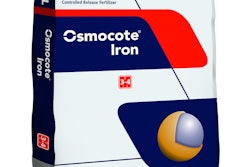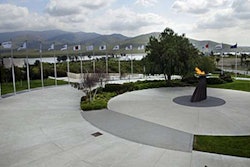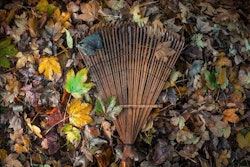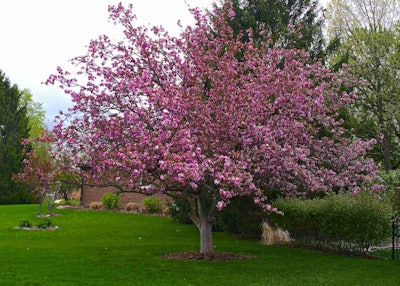 It is important to choose trees that can grow in the given amount of space.
It is important to choose trees that can grow in the given amount of space.Photo: Wplynn/Flickr
The average home consists of 2,500 square feet, almost double the house size in the 1970s, according to U.S. Census data, but that means yards are shrinking and leaving less space for trees.
This seems like a problem, as trees offer multiple benefits and some yards can seem wanting without this landscaping favorite.
As Total Landscape Care noted in its story on topping trees, the practice is ill-advised on many levels. So, if your customer wants a tree in their small space, encourage them to select a tree that won’t grow to be a problem.
When planting a tree near a home’s foundation, the distance between the tree trunk and foundation should be one-third to one-half the maximum tree height.
Here is a list of some popular ornamental trees that offer beautiful color throughout the seasons and won’t grow any larger than 20 feet at mature height.
________________________________________________________
Zuni Crape Myrtle (Lagerstroemia indica x fauriei ‘Zuni’)
The Zuni crape myrtle is a semi-dwarf, multi-stemmed deciduous tree that boasts of rich, dark lavender flowers that bloom from mid-July to September. In the fall, its leaves turn orange-red to maroon and it has multicolored bark that stands out during the winter. Ideal for city gardens and mildew resistant. Grows 9 to 12 feet tall and 8 to 10 feet wide.
- USDA Hardiness Zones: 6-10
- Full sun
________________________________________________________
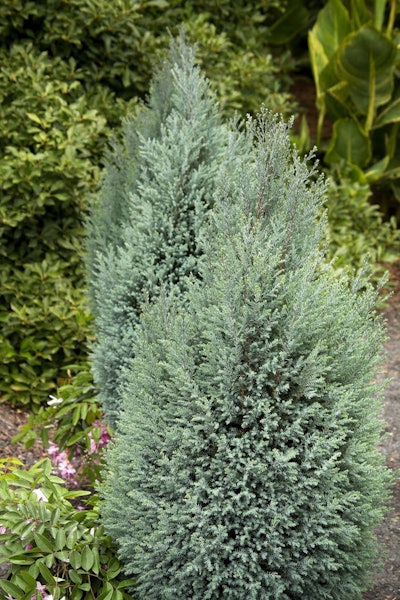 Photo: Monrovia
Photo: MonroviaBlue Surprise Port Orford Cedar (Chamaecyparis lawsoniana ‘Blue Surprise’)
This evergreen features silvery-blue foliage and has a narrow growth habit with dense branches. It can be used for year-round interest or as an accent to low shrub borders. It has a slow growth rate. Monrovia offers this cultivar in the Guardian root stock, which was developed by Oregon State University to be resistant to Phytophthora lateralis. Grows 5 to 10 feet tall and 2 to 4 feet wide.
- USDA Hardiness Zones: 6-9
- Full sun
________________________________________________________
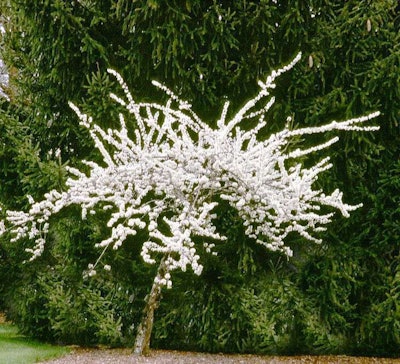 Photo: Monrovia
Photo: MonroviaTina Sargent Crabapple (Malus sargentii ‘Tina’)
A dwarf variety of crabapple that is particularly cold hardy, Tina Sargent features red buds that blossom into white flowers in April and May. It produces bright red berries that can attract birds. Its waving branches make it a good choice for a specimen planting and it stands out best against a background of dark evergreens. Grows 2 to 4 feet tall and 4 to 5 feet wide.
- USDA Hardiness Zones: 4-8
- Full sun
________________________________________________________
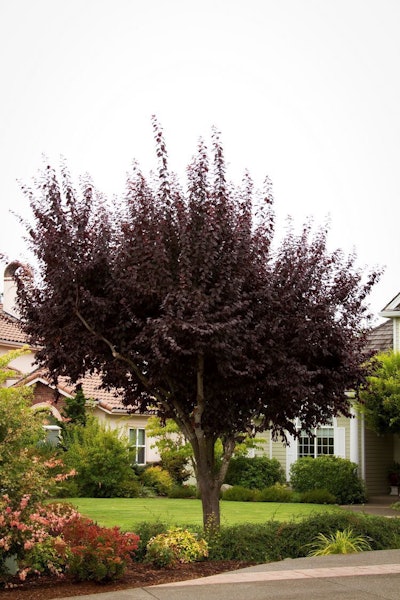 Photo: Monrovia
Photo: MonroviaThundercloud Purple Leaf Plum (Prunus cerasifera ‘Thundercloud’)
Also commonly called a cherry plum, this tree creates stunning pink spring blossoms much like a cherry tree would. Like its name would suggest, Thundercloud has deep purple foliage much like a looming storm. To achieve this foliage, be sure to plant it in full sun; the leaves turn chartreuse if in too much shade. Attracts both birds and butterflies. Grows 20 feet tall and wide.
- USDA Hardiness Zones: 4-9
- Full sun
________________________________________________________
Pacific Fire Vine Maple (Acer circinatum ‘Pacific Fire’)
During the summer, this vine maple produces lime green leaves that turn gold by the fall. Its brilliant red stems make it an excellent choice for winter interest. As the tree grows, the older branches turn a softer orange-red. It thrives in well-drained soil but can tolerate sand and clay. Grows 8 to 10 feet tall and 6 feet wide.
- USDA Hardiness Zones: 5-9
- Partial to full sun
________________________________________________________
Forever Goldie Golden Arborvitae (Thuja pilcata ‘4ever Goldy’)
A golden evergreen that does not shed, its foliage will take an orange hue in fall. It has a columnar shape that can be used in containers or at the back of a border. It tolerates a range of soils and has scented foliage. Heat tolerant. Grows 15 to 20 feet tall and 3 to 4 feet wide.
- USDA Hardiness Zones: 3-7
- Full sun
________________________________________________________
Jade Butterfly Maidenhair Tree (Ginkgo biloba ‘Jade Butterfly’)
A deciduous, dwarf variety of ginkgo, the Jade Butterfly Maidenhair Tree is a fruitless male. It has lovely green leaves that turn a bright yellow in the fall. It can handle both alkaline and acidic soils. Slow-growing and deer resistant. Grows 12 to 15 feet tall and up to 10 feet wide.
- USDA Hardiness Zones: 4-9
- Full sun
________________________________________________________
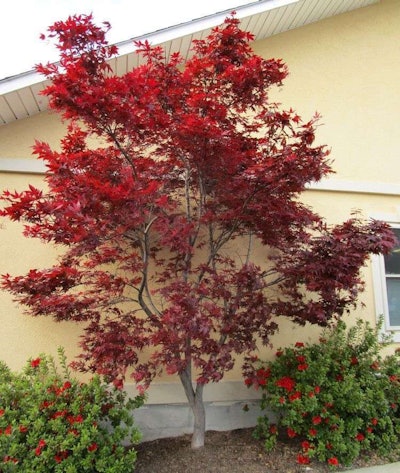 Photo: Monrovia
Photo: MonroviaEmperor I Japanese Maple (Acer palmatum ‘Wolff’)
A cold hardy variety of Japanese maple that features blackish-red bark. One of the best cultivars for smaller city yards, it can be used to accent entries or around an outdoor living space. In the fall, the leaves turn a burning red. The color is most intense in full sun, but for hotter climates it is best to plant it in a partial sun area. Grows 15 feet tall and wide.
- USDA Hardiness Zones: 5-8
- Partial to full sun

